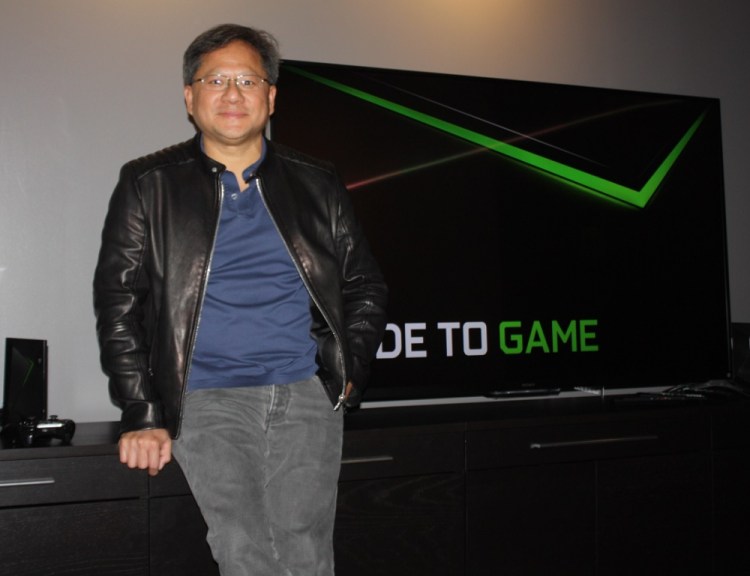We’ve seen the craze around virtual reality before, like when the 3D graphics chip industry was born in the 1990s. Back then, dozens of graphics chip makers were born. Of those, the sole survivor of stand-alone graphics chips is Nvidia, which competes with Intel and Advanced Micro Devices.
Nvidia chief executive Jen-Hsun Huang says his company is in touch with more than 250 companies that are doing some form of virtual reality. Huang wants immersive virtual reality to thrive because it increases demand for Nvidia’s own graphics processing units, or GPUs. Nvidia is the world’s largest designer of standalone graphics chips, and GPUs account for the bulk of the Santa Clara, California-based company’s $1.2 billion in quarterly revenues.
When Huang does his quarterly conference call with analysts during earnings season, he rarely talks much about Nvidia’s own initiatives in gaming. That’s because the Nvidia Shield set-top box and the GeForce Now cloud gaming service are relatively small parts of the business at the moment. But these experiments, in which Nvidia is reaching out directly to sell game devices and services directly to gamers, represent the cutting edge of game technology.
After the company’s third-quarter analyst call last week, we caught up with Huang to ask our own questions on games. And we found he’s very excited about the company’s gaming experiments. Here’s an edited transcript of our interview.
GamesBeat: I know Shield is too small a business to talk about in the grand scheme of things in your quarterly announcements, but I’m curious what you’re learning about Shield and GeForce Now and the audience that is interested in them.
Jen-Hsun Huang: I’ve learned that Shield and GeForce Now are home runs. They delivered on the promise they made. The people who use them are enjoying them.
It’s going to be a long-term [project]. This is really about the future of gaming. We’re just going to have to keep at it. But the people who’ve used GeForce Now, the production release we made, the joy that it’s bringing them is fantastic. We lived up to the promise we made.
We were talking about smart TVs and how this was going to be important to the future of television. It’s pretty clear now that we’re one of the forces out there. Our smart TV is the most advanced. It’s biased toward people who like advanced technology and gaming. It’s a lot like the feel of GeForce versus integrated graphics, the PC versus a smart TV console. Our bias, our specialty, our slant is really about making the perfect gaming platforming.
In the case of GeForce Now, I think the future is unquestionably going to be about services in the cloud. For gaming it’s going to take longer because it’s much more complicated, but it’s going to be there someday.
GamesBeat: Is it more gamers or non-gamers who are interested?
Huang: Our research suggests that gamers and people who are technology-savvy are buying into it.
GamesBeat: How do you feel about the business model of going direct to consumers? Is that working out the way you’d like?
Huang: I love it. It allows to deliver on the promise to our gamers. It allows us to continue to refine the software every single day. If you’re going through a bunch of OEMs you can’t guarantee the experience. In our case, keeping the software updated and fresh—In gaming that’s vitally important. I don’t know how anybody else would do this on our behalf and do it as well as we do.
GamesBeat: You mentioned that you’re in touch with 250 VR companies in some way. I wonder if that reminds you of the way the graphics chip business started.
Huang: Not all of them are going to make it. We’re working with some that are head-mount displays, some that are virtual reality cameras, some that are software stacks or engines, some that are applications, some that are making amusements or location-based entertainment, some that are in design, some that are in medical, some that are in communications. It’s craziness. I’m sure you see the same thing. VR is a computing platform approach. It’s not a market. This new capability is enabling a lot of markets.
GamesBeat: Do you think it’s too much or just right, as far as the appropriateness of having so many companies interested in doing VR?
Huang: It’s almost appropriate, because there are so many industries. People in the automotive industry are working on VR. People in design, architecture, location-based entertainment. All of these industries are completely unrelated. The one thing that is related is that they all need a platform to do their work. That’s what DesignWorks VR and GameWorks VR are for. It gives them an SDK to build their services on top.
Then you have to multiply by the number of geographies. There are some in China, some in the U.S., some in Europe, some in Latin America. It’s all over the place. It’s good. I would agree that if there were 17 head-mount display companies all trying to go after gaming, that would be a waste. But there aren’t.
GamesBeat: How is Windows 10 gaming looking so far?
Huang: Windows 10 has been fantastic. I skipped two versions of Windows, but I have a new Surface Book coming my way. It’s the first Windows in a long time – since Windows XP, to tell you the truth. Windows XP I really loved. Windows 95 I totally loved. And gaming on it is fantastic.
VentureBeat's mission is to be a digital town square for technical decision-makers to gain knowledge about transformative enterprise technology and transact. Learn More



